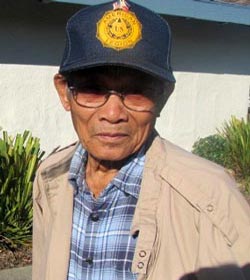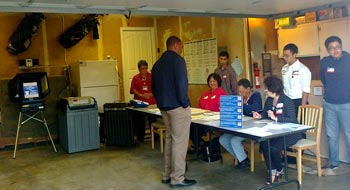The U.S. presidential election - through the CenPEG lens

FilAm voter. CenPEG photo
SAN FRANCISCO, California - The Objective: To observe the U.S. presidential election on Nov. 6, 2012.
The Focus: How the computerization works in the U.S. election.
Last Nov. 6, CenPEG monitored the U.S. general election with two teams covering several cities of California, namely, Richmond, Daly, Union, and Oakland. The teams, comprised of CenPEG Executive Director Evita L.Jimenez, IT Fellow Pablo R. Manalastas, and Bobby M. Tuazon, Director for Policy Studies, were assisted by a poll watcher from the Asian Law Caucus and other volunteers.
Unlike in the Philippines where precincts are clustered around public schools the voting scheme in California – as elsewhere in the U.S. – was conducted right where communities of voters reside. At 7 a.m. when voting started, a garage used as a precinct in Union City, was ready for the early voters. The city uses the paper ballot with the two ballots cast into a voting machine/scanner. Other voters who had earlier filled up and sealed their ballots dropped their voting sheets into a ballot box.
Like other voting precincts, this garage-based center is voter-friendly with a different booth for the disabled while those with impaired vision can use a touch-screen machine assisted by a poll volunteer. Five languages were used for the ballots and election information for this multi-ethnic city of about 80,000 people: English, Spanish, Chinese, Vietnamese, and Filipino. Although there is an official 10-minute time limit for each voter still voters are generally allowed to spend more time.

Proud Hispanic mom shows baby’s ‘I Voted’ sticker. CenPEG photo
The voting desk at this center is manned by the precinct coordinator, precinct inspector, an inspector-judge, three clerks, and three high school poll volunteers. This is the uniform set-up in other voting centers of California based in public schools, community centers, garages, hotel lobbies, school corridors, and other locations.
Initially the CenPEG election observers noted the absence of a verifiability feature that allows the voter to know whether his or her vote was counted. Election-day technical glitches were likewise reported. For example, a vote cast for re-electionist president Barack Obama kept on being counted as a vote for the Republican Party candidate, Mitt Romney. Some voters were not allowed to vote in the absence of their name in the registration list. Several public interest groups and NGOs have deployed election watchers to monitor reports of voting disfranchisement.
It’s still early to say whether the whole election went on smoothly. Previous presidential, general, and state elections had been marred by electronic fraud. But at a little past 11 p.m. on Nov. 6, Romney conceded to Obama. Obama won 303 electoral votes against Romney’s 203. The re-elected president also received 51.3 million popular votes ahead of his rival’s 51.0 million.
The Nov. 6 election was unprecedented in some ways: Obama garnered 55% of the women votes (43% for Romney); 93% of the African-American votes (Romney had 6%); 69% of the Hispanic votes (29% for Romney); and 74% of the Asian votes (25% for Romney). Romney beat Obama for the white American votes (58% vs 40%).

Early voting in garage
- Probing presidential platforms
- Conference calls for people-centered policy actions for Asian development and peace
- WWII 'comfort women' urge visiting Japanese emperor: OFFICIAL GOV’T APOLOGY, UPHOLD TRUTH, and JUST COMPENSATION
- FEARLESS FORECAST (EPISODE II): Comelec will not comply with e-Commerce Law in 2016 elections
- Fearless forecast: Comelec’s non-compliance with the AES law in 2016 (last of 2 parts)
- Fearless forecast: Comelec will not comply with the AES law in 2016
- CenPEG releases travelogue
- Experts: Nuisance bets reflect disillusionment, uneven playing field
- Partylist solon presses for tax cuts
- The True Cost of a Political Campaign
- Management decisions: Based on RA 9369 or purely Comelec’s?
- CenPEG holds 1st roundtable with media on presidential poll results
- Filipino IT can do it!
- FIT4E: The only transparent solution
- Realpolitik in the maritime tiff
- China’s challenge to PH sovereignty
- Choosing the next president
- Fixing the presidency, reforming the state
- New Comelec chair says he’s open to other election technologies
- SC ruling on AES Watch Pabillo and IBP vs Comelec, Smartmatic-TIM
- Comelec must explain P3.2B unliquidated cash advances
- CONGRESS ASKED TO HOLD DEMO ON PCOS HACKING
- 25 Bishops ask poll body to stop midnight deal with Smartmatic
- Pope Francis: reform and conversion
- 2 poll watch coalitions stage rally vs Comelec-Smartmatic midnight deal
- AES Watch questions Comelec-Smartmatic midnight deal
- ASEAN-India: Building Youth Partnerships through Culture and Entrepreneurship
- CenPEG forges research exchange and partnership with Jinan University
- FOI: Bearing fruit or foiled again?
- Remittance with Representation: The right to vote of overseas Filipinos
Center for People Empowewrment in Governance (CenPEG), Philippines. All rights reserved


